Assessment on Managing Personal Work Priorities and Development
VerifiedAdded on 2020/03/07
|13
|2389
|61
Homework Assignment
AI Summary
This assignment explores the critical aspects of managing personal work priorities and fostering professional development. It begins by identifying personal values and setting both personal and professional goals, emphasizing the importance of work-life balance. The assessment then delves into key result areas (KRAs), lead and lag indicators, and the use of a priority matrix for effective planning. Practical techniques for improving performance and organizing work are also discussed. Furthermore, the assignment analyzes a job role, detailing key responsibilities, performance measurement, and alignment with organizational goals. The concept of multiple intelligences and competencies are examined, including the impact of organizational policies and procedures on professional growth. It also covers Kolb’s learning cycle, methods for building management skills, and steps to earn a professional reputation. A SWOT analysis and a personal development plan are included. Finally, the assignment concludes with strategies for developing and expanding a professional network.

MANAGE PERSONAL WORK PRIORITIES AND
PROFESSIONAL DEVELOPMENT
1
PROFESSIONAL DEVELOPMENT
1
Paraphrase This Document
Need a fresh take? Get an instant paraphrase of this document with our AI Paraphraser

TABLE OF CONTENTS
ASSESSMENT 1.............................................................................................................................3
ASSESSMENT 2.............................................................................................................................5
Part A...........................................................................................................................................5
PART B........................................................................................................................................6
ASSESSMENT 3.............................................................................................................................8
Part A...........................................................................................................................................8
Part B............................................................................................................................................9
REFERENCES..............................................................................................................................12
2
ASSESSMENT 1.............................................................................................................................3
ASSESSMENT 2.............................................................................................................................5
Part A...........................................................................................................................................5
PART B........................................................................................................................................6
ASSESSMENT 3.............................................................................................................................8
Part A...........................................................................................................................................8
Part B............................................................................................................................................9
REFERENCES..............................................................................................................................12
2

ASSESSMENT 1
1. What are the ten most important values that shape the way you live your life?
Appreciation
Belief in others
Caring
Commitment
Compassion
Cooperation (Harnett, 2008)
Courtesy
Dedication
Honesty
Integrity
1. Set your personal and professional goals by
a. Use the image below to give yourself a score and draw a spider chart for yourself
3
1. What are the ten most important values that shape the way you live your life?
Appreciation
Belief in others
Caring
Commitment
Compassion
Cooperation (Harnett, 2008)
Courtesy
Dedication
Honesty
Integrity
1. Set your personal and professional goals by
a. Use the image below to give yourself a score and draw a spider chart for yourself
3
⊘ This is a preview!⊘
Do you want full access?
Subscribe today to unlock all pages.

Trusted by 1+ million students worldwide

(Fairclough, 2008)
b. Using your spider chart, develop specific goals for yourself.
1. Goal 1: Need to focus on travel and leisure so that I can explore the world and learn new
things (Carraccio, 2014).
2. Goal 2: Need to earn more and to manage the future so that possession could be obtained
3. Goal 3: Health and fitness is required to be taken into consideration, need to work out
every morning so as to manage the fitness
4. Goal 4: Focus should be developed towards the studies. It is required that targets for the
higher studies should be made. This will help in managing the career and moving towards
better future (Banks, 2013).
5. Goal 5: Grooming and personality development are the two aspects which are required to
be focused upon. This will help in attaining achievements in the interview processes and
will help in getting jobs.
2. Do you believe that you maintain a good work-life balance? Give reasons for your
answer.
Yes, I do maintain a good work life balance as I prefer to keep the balance between my personal
and professional life (Ashton, 2015). I remain professional at my workplace and never bring
work in the personal life. This helps in fulfilling both personal as well as professional life in a
proper way.
3. List three strategies can you put in place to improve your work-life balance?
Tracking the time will help in improving the work life balance (Aldridge, 2009)
Determining the priorities will also help in managing and improving work life balance
Setting goals will also help in managing the work-life balance in an appropriate way.
4
b. Using your spider chart, develop specific goals for yourself.
1. Goal 1: Need to focus on travel and leisure so that I can explore the world and learn new
things (Carraccio, 2014).
2. Goal 2: Need to earn more and to manage the future so that possession could be obtained
3. Goal 3: Health and fitness is required to be taken into consideration, need to work out
every morning so as to manage the fitness
4. Goal 4: Focus should be developed towards the studies. It is required that targets for the
higher studies should be made. This will help in managing the career and moving towards
better future (Banks, 2013).
5. Goal 5: Grooming and personality development are the two aspects which are required to
be focused upon. This will help in attaining achievements in the interview processes and
will help in getting jobs.
2. Do you believe that you maintain a good work-life balance? Give reasons for your
answer.
Yes, I do maintain a good work life balance as I prefer to keep the balance between my personal
and professional life (Ashton, 2015). I remain professional at my workplace and never bring
work in the personal life. This helps in fulfilling both personal as well as professional life in a
proper way.
3. List three strategies can you put in place to improve your work-life balance?
Tracking the time will help in improving the work life balance (Aldridge, 2009)
Determining the priorities will also help in managing and improving work life balance
Setting goals will also help in managing the work-life balance in an appropriate way.
4
Paraphrase This Document
Need a fresh take? Get an instant paraphrase of this document with our AI Paraphraser
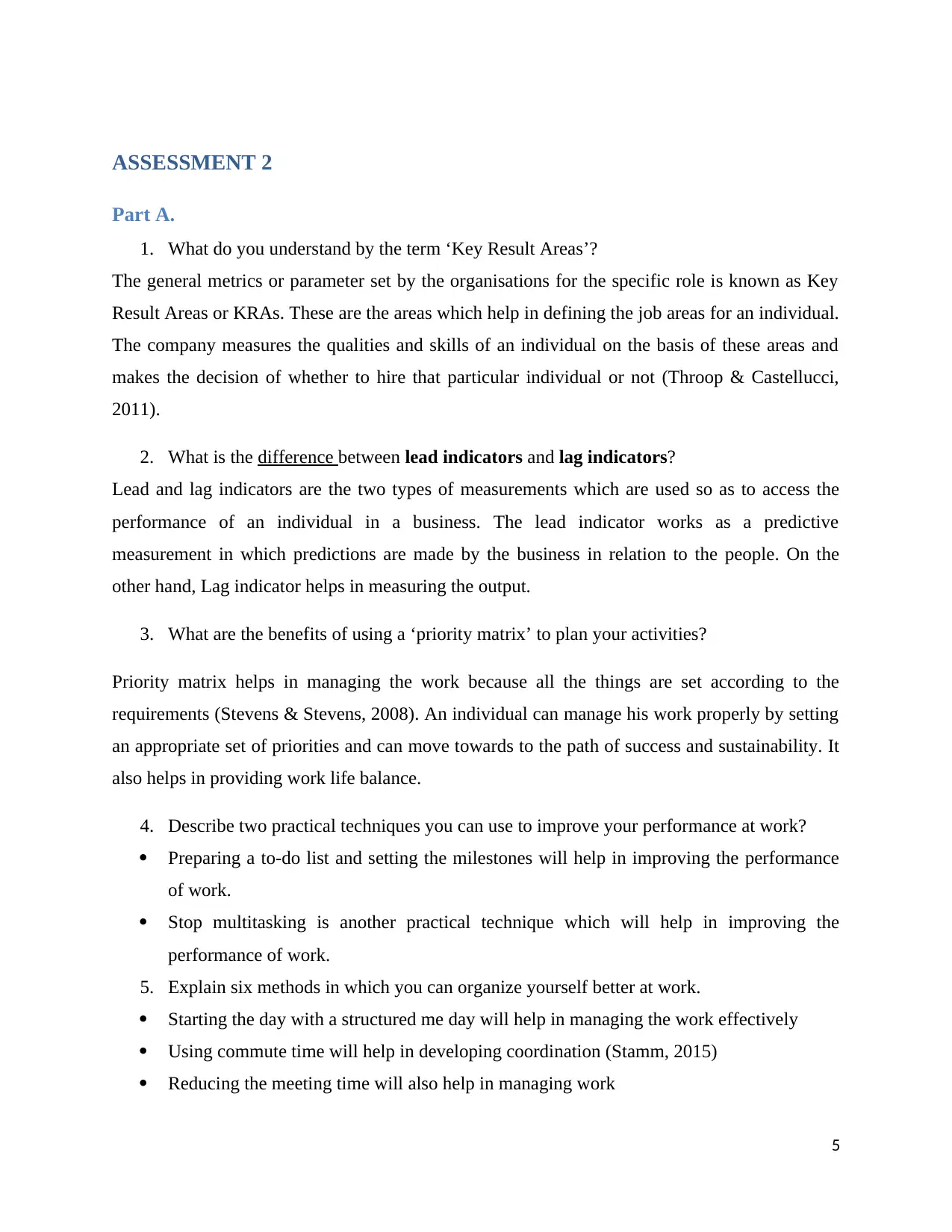
ASSESSMENT 2
Part A.
1. What do you understand by the term ‘Key Result Areas’?
The general metrics or parameter set by the organisations for the specific role is known as Key
Result Areas or KRAs. These are the areas which help in defining the job areas for an individual.
The company measures the qualities and skills of an individual on the basis of these areas and
makes the decision of whether to hire that particular individual or not (Throop & Castellucci,
2011).
2. What is the difference between lead indicators and lag indicators?
Lead and lag indicators are the two types of measurements which are used so as to access the
performance of an individual in a business. The lead indicator works as a predictive
measurement in which predictions are made by the business in relation to the people. On the
other hand, Lag indicator helps in measuring the output.
3. What are the benefits of using a ‘priority matrix’ to plan your activities?
Priority matrix helps in managing the work because all the things are set according to the
requirements (Stevens & Stevens, 2008). An individual can manage his work properly by setting
an appropriate set of priorities and can move towards to the path of success and sustainability. It
also helps in providing work life balance.
4. Describe two practical techniques you can use to improve your performance at work?
Preparing a to-do list and setting the milestones will help in improving the performance
of work.
Stop multitasking is another practical technique which will help in improving the
performance of work.
5. Explain six methods in which you can organize yourself better at work.
Starting the day with a structured me day will help in managing the work effectively
Using commute time will help in developing coordination (Stamm, 2015)
Reducing the meeting time will also help in managing work
5
Part A.
1. What do you understand by the term ‘Key Result Areas’?
The general metrics or parameter set by the organisations for the specific role is known as Key
Result Areas or KRAs. These are the areas which help in defining the job areas for an individual.
The company measures the qualities and skills of an individual on the basis of these areas and
makes the decision of whether to hire that particular individual or not (Throop & Castellucci,
2011).
2. What is the difference between lead indicators and lag indicators?
Lead and lag indicators are the two types of measurements which are used so as to access the
performance of an individual in a business. The lead indicator works as a predictive
measurement in which predictions are made by the business in relation to the people. On the
other hand, Lag indicator helps in measuring the output.
3. What are the benefits of using a ‘priority matrix’ to plan your activities?
Priority matrix helps in managing the work because all the things are set according to the
requirements (Stevens & Stevens, 2008). An individual can manage his work properly by setting
an appropriate set of priorities and can move towards to the path of success and sustainability. It
also helps in providing work life balance.
4. Describe two practical techniques you can use to improve your performance at work?
Preparing a to-do list and setting the milestones will help in improving the performance
of work.
Stop multitasking is another practical technique which will help in improving the
performance of work.
5. Explain six methods in which you can organize yourself better at work.
Starting the day with a structured me day will help in managing the work effectively
Using commute time will help in developing coordination (Stamm, 2015)
Reducing the meeting time will also help in managing work
5
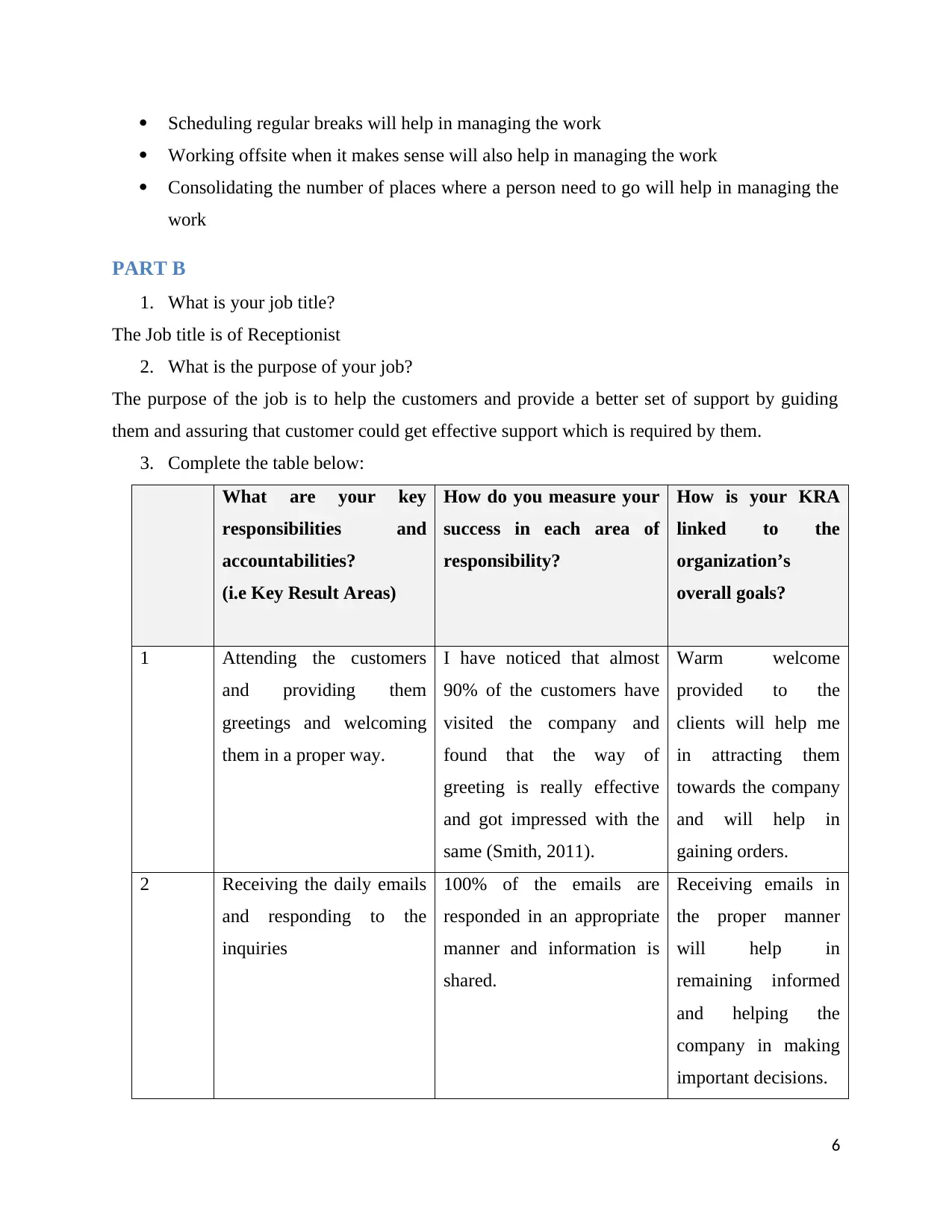
Scheduling regular breaks will help in managing the work
Working offsite when it makes sense will also help in managing the work
Consolidating the number of places where a person need to go will help in managing the
work
PART B
1. What is your job title?
The Job title is of Receptionist
2. What is the purpose of your job?
The purpose of the job is to help the customers and provide a better set of support by guiding
them and assuring that customer could get effective support which is required by them.
3. Complete the table below:
What are your key
responsibilities and
accountabilities?
(i.e Key Result Areas)
How do you measure your
success in each area of
responsibility?
How is your KRA
linked to the
organization’s
overall goals?
1 Attending the customers
and providing them
greetings and welcoming
them in a proper way.
I have noticed that almost
90% of the customers have
visited the company and
found that the way of
greeting is really effective
and got impressed with the
same (Smith, 2011).
Warm welcome
provided to the
clients will help me
in attracting them
towards the company
and will help in
gaining orders.
2 Receiving the daily emails
and responding to the
inquiries
100% of the emails are
responded in an appropriate
manner and information is
shared.
Receiving emails in
the proper manner
will help in
remaining informed
and helping the
company in making
important decisions.
6
Working offsite when it makes sense will also help in managing the work
Consolidating the number of places where a person need to go will help in managing the
work
PART B
1. What is your job title?
The Job title is of Receptionist
2. What is the purpose of your job?
The purpose of the job is to help the customers and provide a better set of support by guiding
them and assuring that customer could get effective support which is required by them.
3. Complete the table below:
What are your key
responsibilities and
accountabilities?
(i.e Key Result Areas)
How do you measure your
success in each area of
responsibility?
How is your KRA
linked to the
organization’s
overall goals?
1 Attending the customers
and providing them
greetings and welcoming
them in a proper way.
I have noticed that almost
90% of the customers have
visited the company and
found that the way of
greeting is really effective
and got impressed with the
same (Smith, 2011).
Warm welcome
provided to the
clients will help me
in attracting them
towards the company
and will help in
gaining orders.
2 Receiving the daily emails
and responding to the
inquiries
100% of the emails are
responded in an appropriate
manner and information is
shared.
Receiving emails in
the proper manner
will help in
remaining informed
and helping the
company in making
important decisions.
6
⊘ This is a preview!⊘
Do you want full access?
Subscribe today to unlock all pages.

Trusted by 1+ million students worldwide

3 Ensuring that the security
could remain maintained
and issues of the customers
could get resolved.
80% of time breach of
security is being managed
and proper response to the
same was provided (Rea,
2012).
Managing the
security system will
help all the
employees as well as
myself in remaining
safe and secure.
4 Updating the calendars
according to the
appointments and
scheduling the meetings
accordingly.
99% of the appointments are
scheduled properly and
support is provided in
removing the clashes of
time.
Maintaining calendar
and appointments
will help in making
my job easy. It will
help in providing
better support to the
company.
5 Keeping eye on the orders
and clients and providing
effective response
80% of the orders are
received without any clashes
or complexity
(Powers, 2015).
This will help in the
growth of the
company which will
help the same in
providing salary to
me as well as will
help in boosting my
career.
7
could remain maintained
and issues of the customers
could get resolved.
80% of time breach of
security is being managed
and proper response to the
same was provided (Rea,
2012).
Managing the
security system will
help all the
employees as well as
myself in remaining
safe and secure.
4 Updating the calendars
according to the
appointments and
scheduling the meetings
accordingly.
99% of the appointments are
scheduled properly and
support is provided in
removing the clashes of
time.
Maintaining calendar
and appointments
will help in making
my job easy. It will
help in providing
better support to the
company.
5 Keeping eye on the orders
and clients and providing
effective response
80% of the orders are
received without any clashes
or complexity
(Powers, 2015).
This will help in the
growth of the
company which will
help the same in
providing salary to
me as well as will
help in boosting my
career.
7
Paraphrase This Document
Need a fresh take? Get an instant paraphrase of this document with our AI Paraphraser
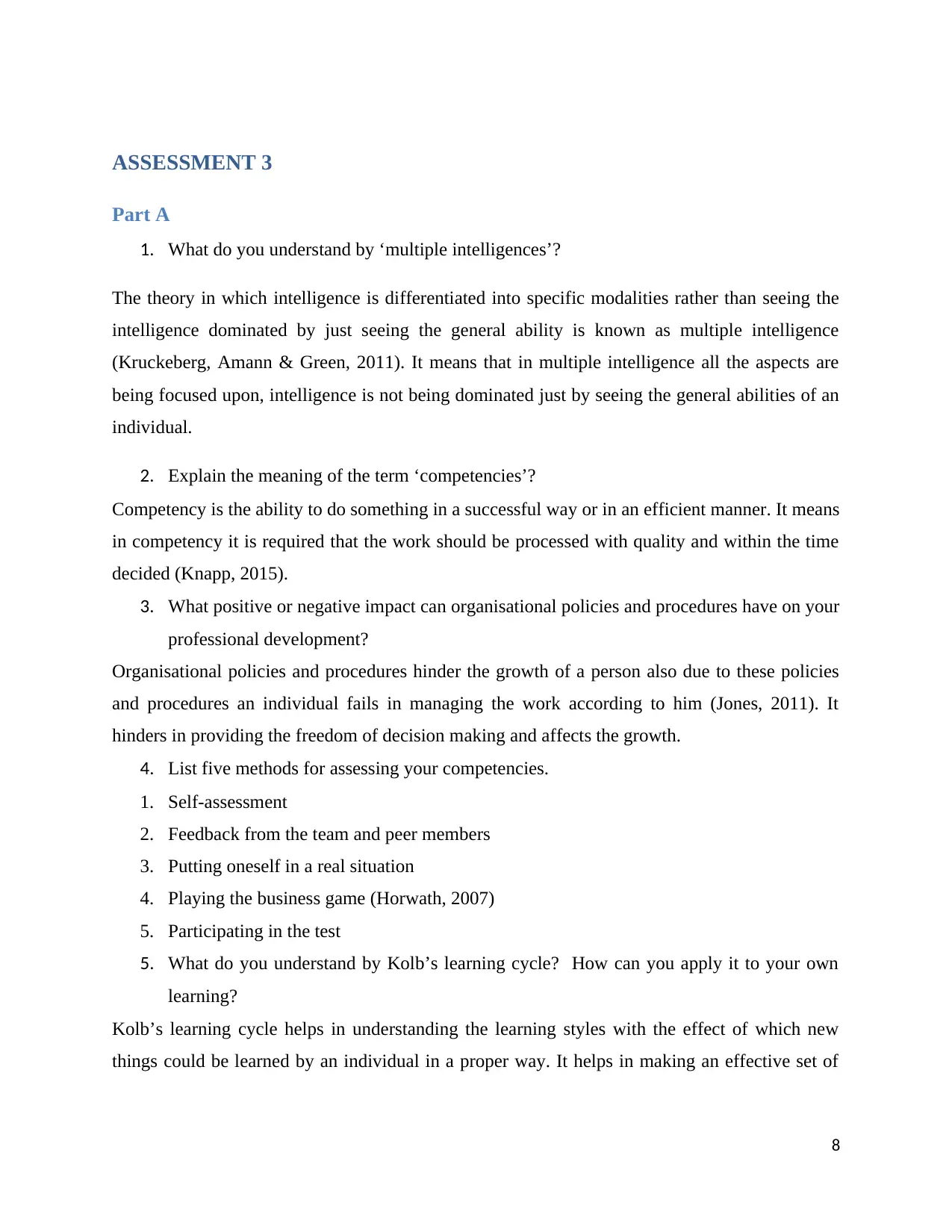
ASSESSMENT 3
Part A
1. What do you understand by ‘multiple intelligences’?
The theory in which intelligence is differentiated into specific modalities rather than seeing the
intelligence dominated by just seeing the general ability is known as multiple intelligence
(Kruckeberg, Amann & Green, 2011). It means that in multiple intelligence all the aspects are
being focused upon, intelligence is not being dominated just by seeing the general abilities of an
individual.
2. Explain the meaning of the term ‘competencies’?
Competency is the ability to do something in a successful way or in an efficient manner. It means
in competency it is required that the work should be processed with quality and within the time
decided (Knapp, 2015).
3. What positive or negative impact can organisational policies and procedures have on your
professional development?
Organisational policies and procedures hinder the growth of a person also due to these policies
and procedures an individual fails in managing the work according to him (Jones, 2011). It
hinders in providing the freedom of decision making and affects the growth.
4. List five methods for assessing your competencies.
1. Self-assessment
2. Feedback from the team and peer members
3. Putting oneself in a real situation
4. Playing the business game (Horwath, 2007)
5. Participating in the test
5. What do you understand by Kolb’s learning cycle? How can you apply it to your own
learning?
Kolb’s learning cycle helps in understanding the learning styles with the effect of which new
things could be learned by an individual in a proper way. It helps in making an effective set of
8
Part A
1. What do you understand by ‘multiple intelligences’?
The theory in which intelligence is differentiated into specific modalities rather than seeing the
intelligence dominated by just seeing the general ability is known as multiple intelligence
(Kruckeberg, Amann & Green, 2011). It means that in multiple intelligence all the aspects are
being focused upon, intelligence is not being dominated just by seeing the general abilities of an
individual.
2. Explain the meaning of the term ‘competencies’?
Competency is the ability to do something in a successful way or in an efficient manner. It means
in competency it is required that the work should be processed with quality and within the time
decided (Knapp, 2015).
3. What positive or negative impact can organisational policies and procedures have on your
professional development?
Organisational policies and procedures hinder the growth of a person also due to these policies
and procedures an individual fails in managing the work according to him (Jones, 2011). It
hinders in providing the freedom of decision making and affects the growth.
4. List five methods for assessing your competencies.
1. Self-assessment
2. Feedback from the team and peer members
3. Putting oneself in a real situation
4. Playing the business game (Horwath, 2007)
5. Participating in the test
5. What do you understand by Kolb’s learning cycle? How can you apply it to your own
learning?
Kolb’s learning cycle helps in understanding the learning styles with the effect of which new
things could be learned by an individual in a proper way. It helps in making an effective set of
8
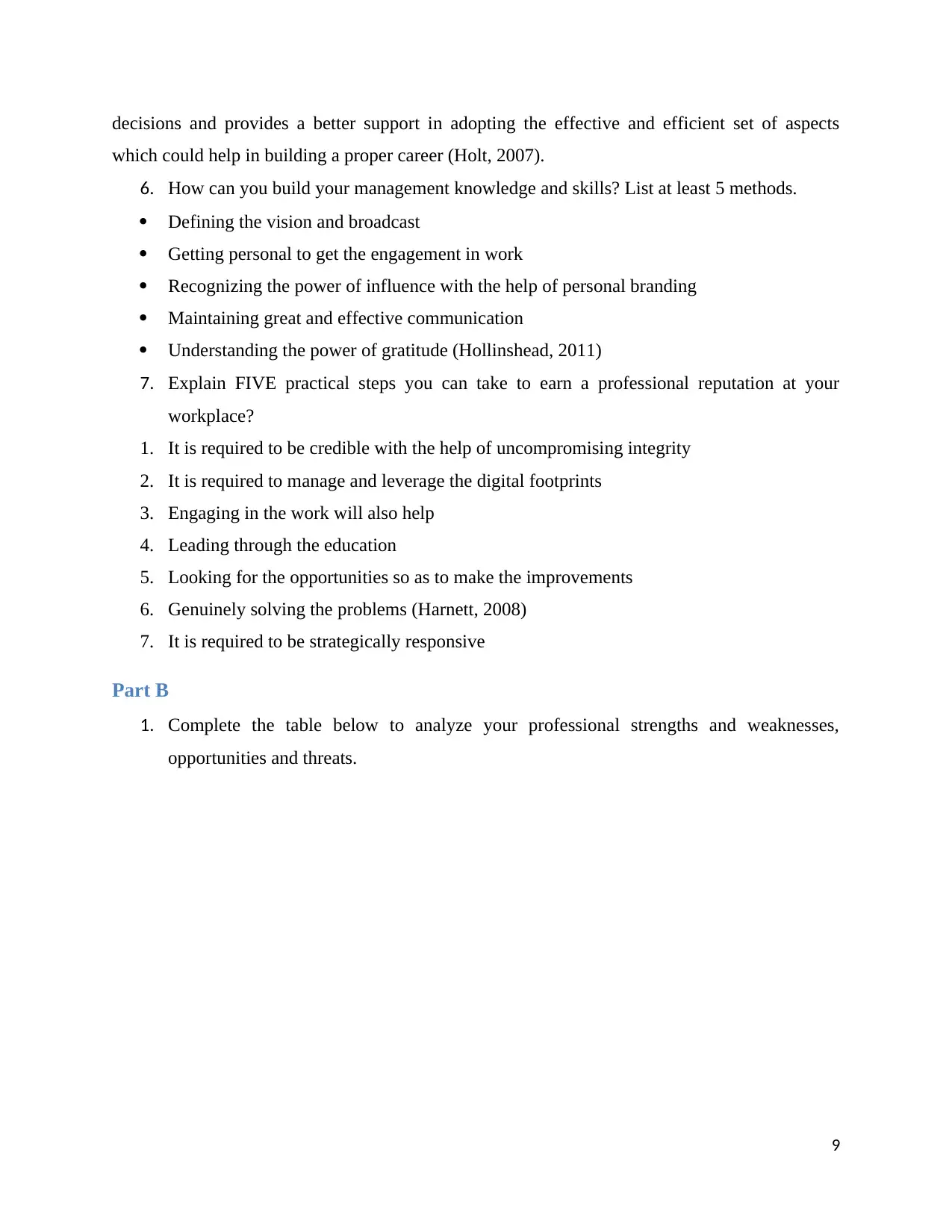
decisions and provides a better support in adopting the effective and efficient set of aspects
which could help in building a proper career (Holt, 2007).
6. How can you build your management knowledge and skills? List at least 5 methods.
Defining the vision and broadcast
Getting personal to get the engagement in work
Recognizing the power of influence with the help of personal branding
Maintaining great and effective communication
Understanding the power of gratitude (Hollinshead, 2011)
7. Explain FIVE practical steps you can take to earn a professional reputation at your
workplace?
1. It is required to be credible with the help of uncompromising integrity
2. It is required to manage and leverage the digital footprints
3. Engaging in the work will also help
4. Leading through the education
5. Looking for the opportunities so as to make the improvements
6. Genuinely solving the problems (Harnett, 2008)
7. It is required to be strategically responsive
Part B
1. Complete the table below to analyze your professional strengths and weaknesses,
opportunities and threats.
9
which could help in building a proper career (Holt, 2007).
6. How can you build your management knowledge and skills? List at least 5 methods.
Defining the vision and broadcast
Getting personal to get the engagement in work
Recognizing the power of influence with the help of personal branding
Maintaining great and effective communication
Understanding the power of gratitude (Hollinshead, 2011)
7. Explain FIVE practical steps you can take to earn a professional reputation at your
workplace?
1. It is required to be credible with the help of uncompromising integrity
2. It is required to manage and leverage the digital footprints
3. Engaging in the work will also help
4. Leading through the education
5. Looking for the opportunities so as to make the improvements
6. Genuinely solving the problems (Harnett, 2008)
7. It is required to be strategically responsive
Part B
1. Complete the table below to analyze your professional strengths and weaknesses,
opportunities and threats.
9
⊘ This is a preview!⊘
Do you want full access?
Subscribe today to unlock all pages.

Trusted by 1+ million students worldwide
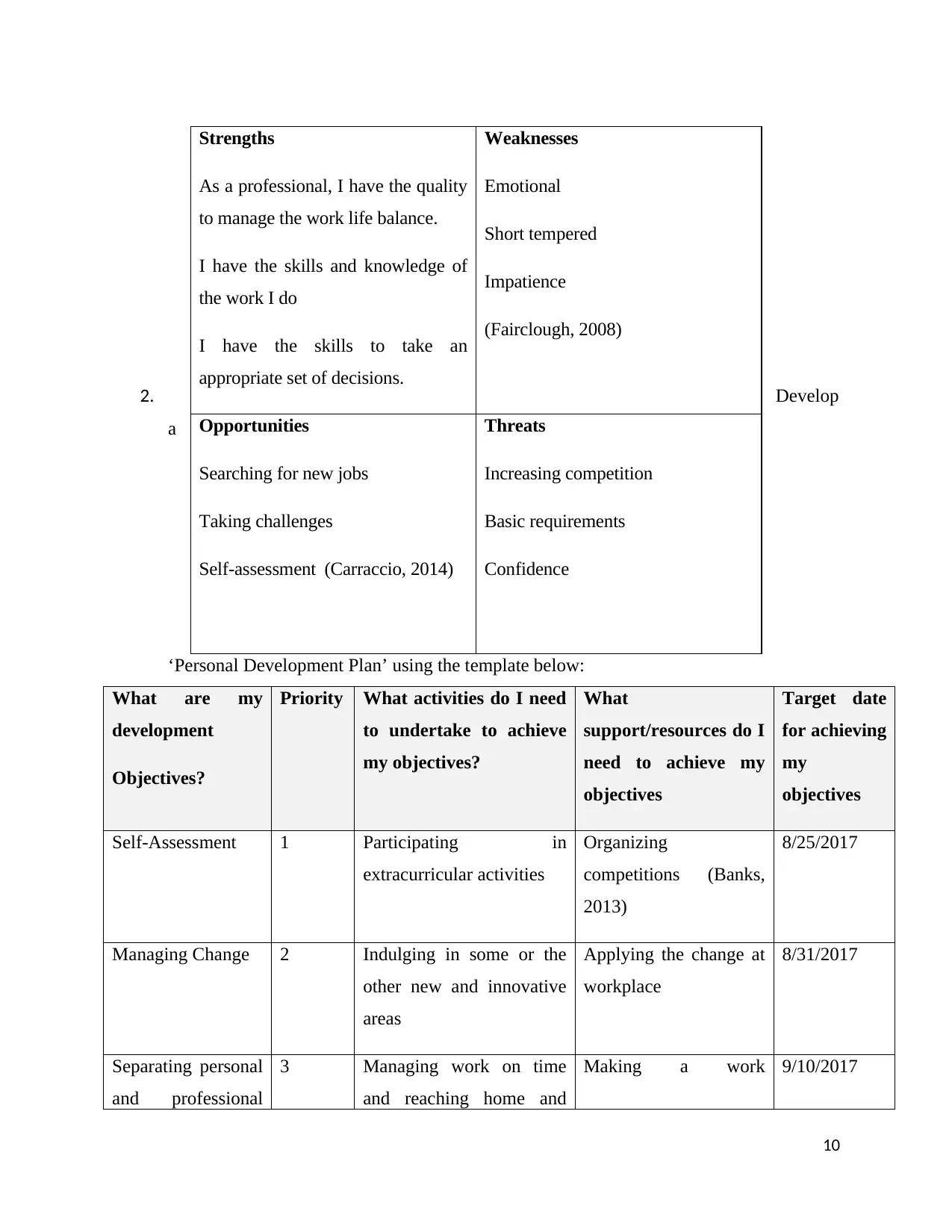
2. Develop
a
‘Personal Development Plan’ using the template below:
What are my
development
Objectives?
Priority What activities do I need
to undertake to achieve
my objectives?
What
support/resources do I
need to achieve my
objectives
Target date
for achieving
my
objectives
Self-Assessment 1 Participating in
extracurricular activities
Organizing
competitions (Banks,
2013)
8/25/2017
Managing Change 2 Indulging in some or the
other new and innovative
areas
Applying the change at
workplace
8/31/2017
Separating personal
and professional
3 Managing work on time
and reaching home and
Making a work 9/10/2017
10
Strengths
As a professional, I have the quality
to manage the work life balance.
I have the skills and knowledge of
the work I do
I have the skills to take an
appropriate set of decisions.
Weaknesses
Emotional
Short tempered
Impatience
(Fairclough, 2008)
Opportunities
Searching for new jobs
Taking challenges
Self-assessment (Carraccio, 2014)
Threats
Increasing competition
Basic requirements
Confidence
a
‘Personal Development Plan’ using the template below:
What are my
development
Objectives?
Priority What activities do I need
to undertake to achieve
my objectives?
What
support/resources do I
need to achieve my
objectives
Target date
for achieving
my
objectives
Self-Assessment 1 Participating in
extracurricular activities
Organizing
competitions (Banks,
2013)
8/25/2017
Managing Change 2 Indulging in some or the
other new and innovative
areas
Applying the change at
workplace
8/31/2017
Separating personal
and professional
3 Managing work on time
and reaching home and
Making a work 9/10/2017
10
Strengths
As a professional, I have the quality
to manage the work life balance.
I have the skills and knowledge of
the work I do
I have the skills to take an
appropriate set of decisions.
Weaknesses
Emotional
Short tempered
Impatience
(Fairclough, 2008)
Opportunities
Searching for new jobs
Taking challenges
Self-assessment (Carraccio, 2014)
Threats
Increasing competition
Basic requirements
Confidence
Paraphrase This Document
Need a fresh take? Get an instant paraphrase of this document with our AI Paraphraser
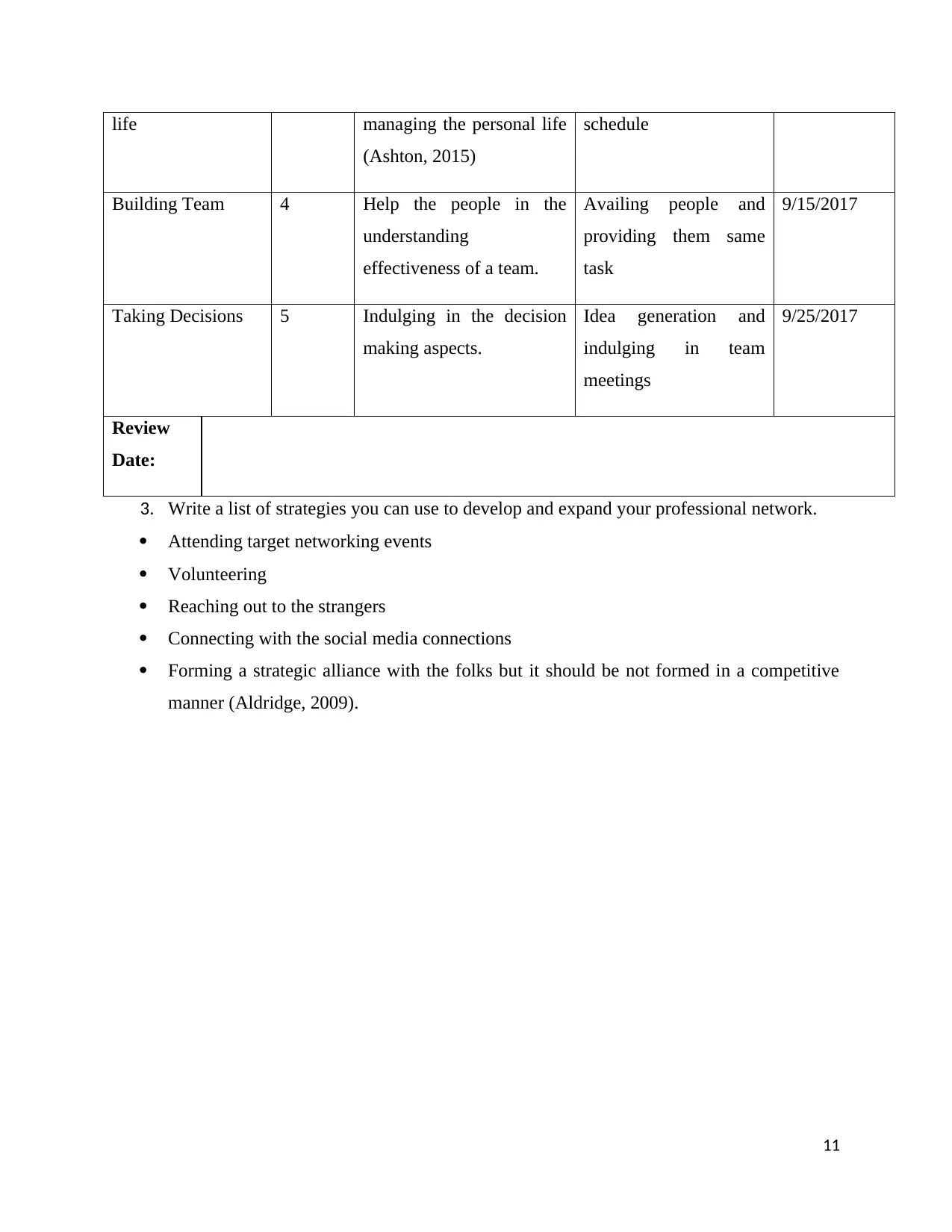
life managing the personal life
(Ashton, 2015)
schedule
Building Team 4 Help the people in the
understanding
effectiveness of a team.
Availing people and
providing them same
task
9/15/2017
Taking Decisions 5 Indulging in the decision
making aspects.
Idea generation and
indulging in team
meetings
9/25/2017
Review
Date:
3. Write a list of strategies you can use to develop and expand your professional network.
Attending target networking events
Volunteering
Reaching out to the strangers
Connecting with the social media connections
Forming a strategic alliance with the folks but it should be not formed in a competitive
manner (Aldridge, 2009).
11
(Ashton, 2015)
schedule
Building Team 4 Help the people in the
understanding
effectiveness of a team.
Availing people and
providing them same
task
9/15/2017
Taking Decisions 5 Indulging in the decision
making aspects.
Idea generation and
indulging in team
meetings
9/25/2017
Review
Date:
3. Write a list of strategies you can use to develop and expand your professional network.
Attending target networking events
Volunteering
Reaching out to the strangers
Connecting with the social media connections
Forming a strategic alliance with the folks but it should be not formed in a competitive
manner (Aldridge, 2009).
11

REFERENCES
Aldridge, K. (2009). Manage personal work priorities and professional development.
Chatswood, N.S.W.: Software Publications.
Ashton, K. (2015). New Registered Nurses’ Personal Responses to Professional
Practice. Journal For Nurses In Professional Development, 31(1), 9-14.
Banks, S. (2013). Negotiating personal engagement and professional accountability: professional
wisdom and ethics work. European Journal Of Social Work, 16(5), 587-604.
Carraccio, C. (2014). Competency 3. Manage conflict between personal and professional
responsibilities. Academic Pediatrics, 14(2), S84-S85.
Fairclough, M. (2008). Supporting Learners in the Lifelong Learning Sector. Maidenhead:
McGraw-Hill International (UK) Ltd.
Harnett, P. (2008). Understanding primary education. London: Routledge.
Hollinshead, A. (2011). Effective group work with young people. Professional Development In
Education, 37(1), 166-167.
Holt, T. (2007). Balanced Priorities. SPIE Professional, 3-19.
Horwath, J. (2007). The Missing Assessment Domain: Personal, Professional and Organizational
Factors Influencing Professional Judgements when Identifying and Referring Child
Neglect. British Journal Of Social Work, 37(8), 1285-1303.
Jones, K. (2011). Central, local and individual continuing professional development (CPD)
priorities: changing policies of CPD in Wales. Professional Development In Education, 37(5),
759-776.
Knapp, H. (2015). Therapeutic communication. Los Angeles [u.a.]: SAGE Publ.
Kruckeberg, K., Amann, W., & Green, M. (2011). Leadership and personal development.
Charlotte, N.C.: Information Age Pub.
12
Aldridge, K. (2009). Manage personal work priorities and professional development.
Chatswood, N.S.W.: Software Publications.
Ashton, K. (2015). New Registered Nurses’ Personal Responses to Professional
Practice. Journal For Nurses In Professional Development, 31(1), 9-14.
Banks, S. (2013). Negotiating personal engagement and professional accountability: professional
wisdom and ethics work. European Journal Of Social Work, 16(5), 587-604.
Carraccio, C. (2014). Competency 3. Manage conflict between personal and professional
responsibilities. Academic Pediatrics, 14(2), S84-S85.
Fairclough, M. (2008). Supporting Learners in the Lifelong Learning Sector. Maidenhead:
McGraw-Hill International (UK) Ltd.
Harnett, P. (2008). Understanding primary education. London: Routledge.
Hollinshead, A. (2011). Effective group work with young people. Professional Development In
Education, 37(1), 166-167.
Holt, T. (2007). Balanced Priorities. SPIE Professional, 3-19.
Horwath, J. (2007). The Missing Assessment Domain: Personal, Professional and Organizational
Factors Influencing Professional Judgements when Identifying and Referring Child
Neglect. British Journal Of Social Work, 37(8), 1285-1303.
Jones, K. (2011). Central, local and individual continuing professional development (CPD)
priorities: changing policies of CPD in Wales. Professional Development In Education, 37(5),
759-776.
Knapp, H. (2015). Therapeutic communication. Los Angeles [u.a.]: SAGE Publ.
Kruckeberg, K., Amann, W., & Green, M. (2011). Leadership and personal development.
Charlotte, N.C.: Information Age Pub.
12
⊘ This is a preview!⊘
Do you want full access?
Subscribe today to unlock all pages.

Trusted by 1+ million students worldwide
1 out of 13
Related Documents
Your All-in-One AI-Powered Toolkit for Academic Success.
+13062052269
info@desklib.com
Available 24*7 on WhatsApp / Email
![[object Object]](/_next/static/media/star-bottom.7253800d.svg)
Unlock your academic potential
Copyright © 2020–2025 A2Z Services. All Rights Reserved. Developed and managed by ZUCOL.





